
Concept explainers
a
Introduction: Immediately after a business combination, the parent company records income and dividends from the subsidiary using the equity method. In addition, parents must also write off a portion of the differential of the excess acquisition price. Further, all the intercompany transactions must be eliminated before the preparation of consolidated financial statements.
The amount did P pay for the shares if no
b
Introduction: Immediately after a business combination, the parent company records income and dividends from the subsidiary using the equity method. In addition, parents must also write off a portion of the differential of the excess acquisition price. Further, all the intercompany transactions must be eliminated before the preparation of consolidated financial statements.
The amount P pays for the share if non-controlling interest at acquisition is $54,000 and goodwill is $40,000
c
Introduction: Immediately after a business combination, the parent company records income and dividends from the subsidiary using the equity method. In addition, parents must also write off a portion of the differential of the excess acquisition price. Further, all the intercompany transactions must be eliminated before the preparation of consolidated financial statements.
The amount non-controlling interest in consolidated
Want to see the full answer?
Check out a sample textbook solution
Chapter 5 Solutions
Advanced Financial Accounting
- 4 MARKSarrow_forwardQuestion-9 When should specialized allocation hierarchies replace standard methods? a) Standard methods fit all cases b) Complex resource sharing demands structured distribution approaches c) Specialization adds confusion d) Equal splitting works betterarrow_forwardProvide Answerarrow_forward
- Global tech solutions ? Financial accountingarrow_forwardCompute the predetermined overhead rate for each activity base.arrow_forwardOriole Home Supply Company received proceeds of $735000 on 10-year, 9% bonds issued on January 1, 2025. The bonds had a face value of $786000, pay interest annually on December 31, and have a call price of 102. Oriole Home Supply uses the straight-line method of amortization. What is the amount of interest Oriole Home Supply will pay bondholders in 2025? ○ $66150 $75840 ○ $70740 ○ $65640arrow_forward
- 4500 bonds with a face value of $1000 each, are sold at 101. The entry to record the issuance is Cash Premium on Bonds Payable Bonds Payable 4545000 45000 4500000 Cash 4545000 Bonds Payable 4545000 Cash Premium on Bonds Payable Bonds Payable Cash Discount on Bonds Payable Bonds Payable 4500000 45000 4545000 4545000 45000 4500000arrow_forwardNet sales for the year were $2,790,000 and cost of goods sold was $2,050,000 for the company's existing products. A new product is presently under development and will have an expected selling price of not more than $74 per unit in order to remain competitive with similar products in the marketplace. Calculate gross profit and the gross profit ratio for the year.arrow_forward4500 bonds with a face value of $1000 each, are sold at 101. The entry to record the issuance is Cash Premium on Bonds Payable Bonds Payable 4545000 45000 4500000 Cash 4545000 Bonds Payable 4545000 Cash Premium on Bonds Payable Bonds Payable Cash Discount on Bonds Payable Bonds Payable 4500000 45000 4545000 4545000 45000 4500000arrow_forward
 Intermediate Accounting: Reporting And AnalysisAccountingISBN:9781337788281Author:James M. Wahlen, Jefferson P. Jones, Donald PagachPublisher:Cengage Learning
Intermediate Accounting: Reporting And AnalysisAccountingISBN:9781337788281Author:James M. Wahlen, Jefferson P. Jones, Donald PagachPublisher:Cengage Learning

